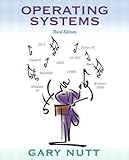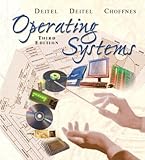|
|
Help |
| Home - Computer - Operating Systems (Books) | |
e99 Online Shopping Mall
|
|
Help |
| Home - Computer - Operating Systems (Books) | |
| Back | 41-60 of 100 | Next 20 |
click price to see details click image to enlarge click link to go to the store
| 41. MCDST Self-Paced Training Kit (Exam 70-271): Supporting Users and Troubleshooting a Microsoft Windows XP Operating System (Pro-Certification) by Walter Glenn, Tony Northrup | |
 | Hardcover: 848
Pages
(2005-09-28)
list price: US$59.99 -- used & new: US$33.94 (price subject to change: see help) Asin: 0735622272 Average Customer Review: Canada | United Kingdom | Germany | France | Japan |
|
Editorial Review Product Description Focusing on building your ability to resolve end-user incident requests by configuring and troubleshooting the Windows XP operating system in the corporate or home environment, this official study guide covers system installation, managing access to resources, configuring and troubleshooting hardware devices and drivers, configuring and troubleshooting the desktop and user environments, and troubleshooting network protocols and services. Ace your exam preparation by working at your own pace through the lessons, hands-on exercises, and practice tests. The flexible, best-of-class test engine on CD-ROM features 425 practice questions. Choose timed or untimed testing mode, generate random tests or focus on discrete objectives or chapters, and get detailed explanations for right and wrong answers—including pointers back to the book for further study. You also get a 120-day evaluation version of Windows XP software and other resources on the CD, making this kit an exceptional value and a great Customer Reviews (47)
| |
| 42. Embedded Systems and Computer Architecture by Graham R Wilson | |
 | Paperback: 320
Pages
(2002-01-22)
list price: US$78.95 -- used & new: US$42.46 (price subject to change: see help) Asin: 0750650648 Average Customer Review: Canada | United Kingdom | Germany | France | Japan |
|
Editorial Review Product Description Customer Reviews (1)
| |
| 43. The Design and Implementation of the 4.4 BSD Operating System (Addison-Wesley UNIX and Open Systems Series) by Marshall Kirk McKusick, Keith Bostic, Michael J. Karels, John S. Quarterman | |
 | Paperback: 608
Pages
(2010-08-09)
list price: US$79.99 -- used & new: US$60.22 (price subject to change: see help) Asin: 0132317923 Average Customer Review: Canada | United Kingdom | Germany | France | Japan |
|
Editorial Review Product Description Highlights: Customer Reviews (10)
I wish Kirk had decided to show us more of the joy of programming the kernel. If he had, the book would have been worth at least twice it's current price.
Reading through the chapters, it appears that the book could have been rendered more readable if a knowledgeable technical editor had put the finishing touches on it. Nevertheless, even though it takes a bit of time to get used to the different writing styles and differences in quality of several chapters, this books is a well of insights into the internal workings of BSD 4.4 and its derivatives (like Mac OS X). In order to gain the most from this title, I strongly urge interested readers to already have worked their way through Maurice J. Bach's "The Design of the UNIX Operating System".
First, it's a technical book about the BSD kernel. The only reason why you would want to read it is that you really want to know How It Works(tm). It's all about kernel. The drivers are only slightly touched, the API is touched even less. Rather than that, this book shows you the fields and flags of internal structures and the ways they are handled. Therefore I'd only recommend it to the system programmers and may be to the enthusiastic admins. Second, certain chapters are written much worse than the others. The language in chapters 4 (Process Management) and 5 (Memory Management) is sort of a tangled making reading a challenge and it's really a pity because these two topics would better be covered best. Also note that this book does not include sample code AT ALL. All the principles and algorithms are described using plain English and I'd say it's great, because it's much easier to follow, rather than making your way through somebody else's C scribbling. Anyway, 5 stars, because it gives you 500 pages of pure distilled info. And it's info from the authors of BSD ! I'm definetely looking forward to read this book again and this is one of the books that are worth it.
| |
| 44. Principles of Operating Systems: Design and Applications by Brian Stuart | |
 | Hardcover: 600
Pages
(2008-01-15)
list price: US$150.95 -- used & new: US$21.39 (price subject to change: see help) Asin: 1418837695 Average Customer Review: Canada | United Kingdom | Germany | France | Japan |
|
Editorial Review Product Description Customer Reviews (1)
| |
| 45. Inside Linux : A Look at Operating System Development by Randolph Bentson | |
 | Paperback: 290
Pages
(1996-03)
list price: US$22.00 -- used & new: US$93.29 (price subject to change: see help) Asin: 0916151891 Average Customer Review: Canada | United Kingdom | Germany | France | Japan |
Customer Reviews (3)
| |
| 46. Survey of Operating Systems by Charles Holcombe, Jane Holcombe | |
| Paperback: 704
Pages
(2011-04)
list price: US$104.05 -- used & new: US$104.05 (price subject to change: see help) Asin: 0073518174 Average Customer Review: Canada | United Kingdom | Germany | France | Japan | |
|
Editorial Review Product Description Customer Reviews (5)
The book starts off with a hardware overview, which is very helpful in the understanding of software. Then you deal with the older operating systems like Windows 3.X and DOS, this is a nice foundation to learn the roots of the operating system. Then comes NT, 2000, XP and there is even section for the MAC OS and Linux group. What I liked about this book was the exercises and labs; they would prove to very helpful in understanding certain concepts. About the only thing missing is cds with evaluation copies of the operating system(s), in case you don't have access to them. Overall this book is a great compliment to the Mike Meyers All in One A+ Study Guide. As an Instructor, this book becomes a valuable add on to the curriculum.
| |
| 47. Operating Systems (3rd Edition) by Gary Nutt | |
 | Hardcover: 894
Pages
(2003-07-13)
list price: US$149.00 -- used & new: US$39.15 (price subject to change: see help) Asin: 0201773449 Average Customer Review: Canada | United Kingdom | Germany | France | Japan |
|
Editorial Review Product Description Customer Reviews (26)
| |
| 48. Modern Operating Systems 2nd Ed by Tanenbaum | |
 | Paperback: 976
Pages
(2007)
Isbn: 8120320638 Canada | United Kingdom | Germany | France | Japan |
| 49. Understanding Operating Systems by Ann McHoes, Ida M. Flynn | |
 | Paperback: 608
Pages
(2010-02-17)
list price: US$161.95 -- used & new: US$122.30 (price subject to change: see help) Asin: 143907920X Average Customer Review: Canada | United Kingdom | Germany | France | Japan |
|
Editorial Review Product Description Customer Reviews (23)
| |
| 50. Operating Systems Uncovered by eBook | |
 | Kindle Edition:
Pages
(2009-03-01)
list price: US$1.99 Asin: B001U8986I Canada | United Kingdom | Germany | France | Japan |
|
Editorial Review Product Description | |
| 51. The Design and Implementation of the FreeBSD Operating System by Marshall Kirk McKusick, George V. Neville-Neil | |
 | Hardcover: 720
Pages
(2004-08-12)
list price: US$69.99 -- used & new: US$45.00 (price subject to change: see help) Asin: 0201702452 Average Customer Review: Canada | United Kingdom | Germany | France | Japan |
|
Editorial Review Product Description As in earlier Addison-Wesley books on the UNIX-based BSD operating system, Kirk McKusick and George Neville-Neil deliver here the most comprehensive, up-to-date, and authoritative technical information on the internal structure of open source FreeBSD. Readers involved in technical and sales support can learn the capabilities and limitations of the system; applications developers can learn effectively and efficiently how to interface to the system; system administrators can learn how to maintain, tune, and configure the system; and systems programmers can learn how to extend, enhance, and interface to the system. The authors provide a concise overview of FreeBSD's design and implementation. Then, while explaining key design decisions, they detail the concepts, data structures, and algorithms used in implementing the systems facilities. As a result, readers can use this book as both a practical reference and an in-depth study of a contemporary, portable, open source operating system. This book: Already widely used for Internet services and firewalls, high-availability servers, and general timesharing systems, the lean quality of FreeBSD also suits the growing area of embedded systems. Unlike Linux, FreeBSD does not require users to publicize any changes they make to the source code. Customer Reviews (10)
| |
| 52. Complete Red Hat Operating System 5.2 (Software) | |
 | CD-ROM:
Pages
(1998)
-- used & new: US$4.98 (price subject to change: see help) Asin: 1575951991 Canada | United Kingdom | Germany | France | Japan |
| 53. Operating Systems Concepts with Linux and POSIX Threads by Robert P. Cook | |
 | Kindle Edition:
Pages
(2008-07-04)
list price: US$9.99 Asin: B001CKAKRA Canada | United Kingdom | Germany | France | Japan |
|
Editorial Review Product Description | |
| 54. UNIX Operating System (Custom Edition - Strayer Univ.) by Amir Afzal | |
| Paperback:
Pages
(1000)
Isbn: 0536814104 Canada | United Kingdom | Germany | France | Japan | |
| 55. Operating Systems (3rd Edition) by Harvey M. Deitel, Paul J. Deitel, David R. Choffnes | |
 | Hardcover: 1272
Pages
(2003-12-22)
list price: US$154.00 -- used & new: US$44.98 (price subject to change: see help) Asin: 0131828274 Average Customer Review: Canada | United Kingdom | Germany | France | Japan |
|
Editorial Review Product Description Customer Reviews (17)
| |
| 56. The Human Operating system: An Owner's Manual by Larry E. Senn | |
 | Paperback: 178
Pages
(2005)
-- used & new: US$189.50 (price subject to change: see help) Asin: B000VY3QZ6 Canada | United Kingdom | Germany | France | Japan |
| 57. Principles of Modern Operating Systems by Richard Schlesinger, Jose Garrido | |
 | Hardcover: 482
Pages
(2007-08-01)
list price: US$135.95 -- used & new: US$18.95 (price subject to change: see help) Asin: 0763735744 Average Customer Review: Canada | United Kingdom | Germany | France | Japan |
|
Editorial Review Product Description Customer Reviews (2)
| |
| 58. Exploring the Pick Operating System by Jonathan E. Sisk, Steven Van Arsdale | |
| Paperback: 400
Pages
(1989-01)
list price: US$24.95 -- used & new: US$85.00 (price subject to change: see help) Asin: 0672484129 Average Customer Review: Canada | United Kingdom | Germany | France | Japan | |
Customer Reviews (1)
| |
| 59. Operating System Design: The XINU Approach (v. 1) by Douglas Comer | |
 | Paperback: 496
Pages
(1983-11-11)
list price: US$127.80 -- used & new: US$58.65 (price subject to change: see help) Asin: 0136375391 Average Customer Review: Canada | United Kingdom | Germany | France | Japan |
|
Editorial Review Product Description Customer Reviews (8)
| |
| 60. Embedded Systems Design: An Introduction to Processes, Tools and Techniques by Arnold S. Berger | |
 | Paperback: 237
Pages
(2001-12-15)
list price: US$44.95 -- used & new: US$24.59 (price subject to change: see help) Asin: 1578200733 Average Customer Review: Canada | United Kingdom | Germany | France | Japan |
|
Editorial Review Product Description Customer Reviews (16)
| |
| Back | 41-60 of 100 | Next 20 |